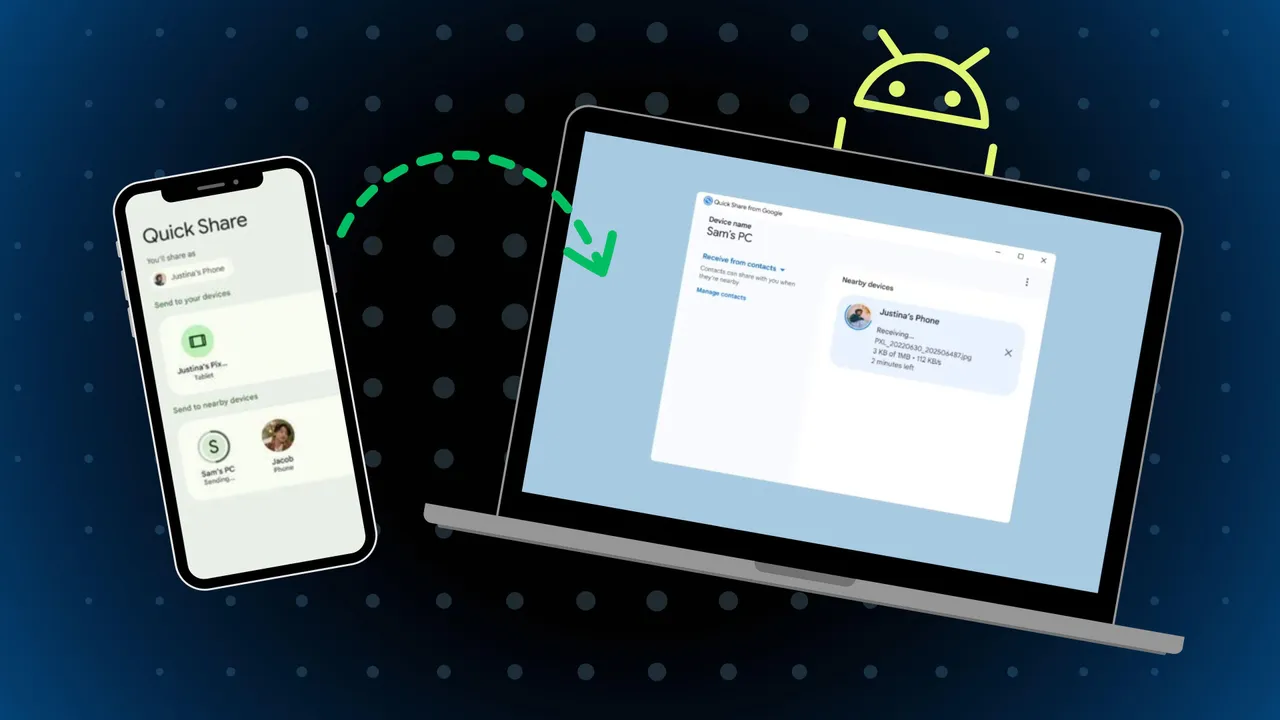Imagine this: you’re at a gathering, and you want to instantly send a bunch of photos to a friend. You’re on Android, and they’re on an iPhone. Instead of a smooth transfer, you’re suddenly fumbling with WhatsApp compression, email attachments, or cloud drives. For years, this ecosystem barrier has been a major frustration.
But that may soon change. Recent discoveries suggest Google is actively working on expanding Quick Share—its AirDrop-like file sharing system—to work with iPhones and potentially macOS. If this happens, it won’t just be another software update. It could reshape the way millions of people share files across competing platforms.
2. What is Quick Share—and Why Cross-Platform Matters
Quick Share was introduced in 2020 as Google’s answer to Apple’s AirDrop. It allows users to transfer photos, videos, documents, and links between Android devices, Chromebooks, and even Windows PCs. It works using a combination of Bluetooth for discovery and Wi-Fi Direct for fast transfer speeds.
Unlike traditional sharing methods, Quick Share doesn’t rely on mobile data or third-party apps. You don’t need to compress files or upload them somewhere first—it’s fast, direct, and often works offline.
Until now, however, it has been largely limited to Android and Google’s ecosystem. That’s where iPhone compatibility becomes a game-changer. If Google pulls this off, file sharing between Android and iOS users could finally become as seamless as AirDrop is within Apple’s world.
3. The Leak That Sparked Excitement
The buzz began when code fragments from a beta version of Google Play Services revealed references to Quick Share with iPhones. These hints suggested that Google is testing functionality to allow Android-to-iPhone file transfers.
One interesting clue was a prompt stating: “To share end-to-end encrypted files with iPhone and other devices, first sign in.” This indicates that Quick Share might require a Google account login when used with iPhones—unlike Android-to-Android transfers, which work without sign-in.
The discovery shows Google is not just considering iOS compatibility, but also building it with additional safeguards. The fact that such references are already inside Google’s own software strongly suggests the company is preparing for a rollout sooner rather than later.
4. Why a Google Account Might Be Required
The sign-in requirement sparked debate, but it makes sense. Here’s why Google may choose to gate iPhone transfers behind an account login:
- Security: Android-to-Android Quick Share already uses encryption, but cross-platform transfers may require stronger verification. Tying transfers to a Google account could help ensure that only authorized devices participate.
- Privacy: With AirDrop, users sometimes face unsolicited file requests in public. Requiring an account could help reduce spam by linking visibility to verified identities.
- Cross-platform consistency: Apple’s iOS ecosystem has its own rigid rules. A Google account system might act as a bridge, ensuring compatibility and making it easier for Google to manage the user experience across platforms.
So, while it adds an extra step, the sign-in requirement could be a small price to pay for smooth Android-iPhone interoperability.
5. What Android and iPhone Users Stand to Gain
The benefits of Quick Share on iPhones are massive.
For Android users:
- No more needing to use messaging apps that compress photos or videos.
- Easier sharing of large files, such as presentations, PDFs, or raw images.
- Faster collaboration between friends, family, or coworkers using iPhones.
For iPhone users:
- A direct way to exchange files with Android friends without relying on email or cloud storage.
- Retention of full file quality, instead of relying on third-party apps that shrink and distort media.
- Potential support for transferring with Chromebooks and Windows laptops, broadening their options.
In short, it reduces friction for everyone. It could finally bridge one of the most annoying gaps between the two dominant mobile platforms.
6. The Bigger Picture: Cross-Platform Harmony
This development isn’t happening in isolation. The tech world has been moving steadily toward cross-platform cooperation:
- USB-C is now a common charging standard, even adopted by Apple for the iPhone 15 series.
- Messaging has seen big steps forward, with iOS agreeing to adopt RCS, improving the quality of photos and videos shared between Android and iPhones.
- Cloud ecosystems are increasingly flexible, with services like Google Drive and iCloud offering easier ways to coexist.
If Quick Share becomes iPhone-compatible, it will mark another milestone in tearing down the “walled gardens” of tech giants. While Apple has historically been reluctant to open up its systems, pressure from global regulators and user demand may make interoperability unavoidable.
7. What’s Still Unknown
Despite the promising leaks, several important details remain unclear:
- Release timeline: Google hasn’t officially confirmed when—or if—Quick Share for iPhone will launch. It could appear in the next Android release, or roll out quietly via Google Play Services updates.
- Feature limitations: Will it work as seamlessly as AirDrop, with instant device discovery and offline transfers? Or will it require apps or internet connectivity?
- Mac compatibility: Will the functionality extend beyond iPhones to include macOS laptops and desktops? That could be a huge win for professionals.
- File size limits: Some sharing tools cap file sizes. It’s not clear whether Quick Share for iOS will have restrictions.
Until Google makes an official announcement, these remain open questions.
8. What to Watch Next
For now, here’s what users should keep an eye on:
- Beta updates: Future Google Play Services updates may reveal more about iPhone compatibility.
- Google events: Announcements could come during upcoming Pixel launches, Android developer summits, or broader Google I/O events.
- Apple’s reaction: Historically, Apple prefers to keep features exclusive. How it responds to Google’s push for interoperability will be fascinating.
If Google manages to roll this out smoothly, the move could set a precedent for other forms of cross-platform sharing—possibly even extending into messaging, streaming, or gaming ecosystems.
9. Conclusion
Google’s effort to make Quick Share compatible with iPhones is more than just a convenience feature. It represents a shift toward breaking down ecosystem barriers, improving user experience, and meeting the growing demand for cross-platform functionality.
For years, sending files between Android and iPhones has been unnecessarily difficult. If Quick Share fulfills its promise, it could put an end to that frustration once and for all. More importantly, it would signal that even the fiercest rivals in tech are beginning to accept one reality: users want seamless, universal connections.
This could be the beginning of a new era where interoperability isn’t a luxury—it’s the standard.

